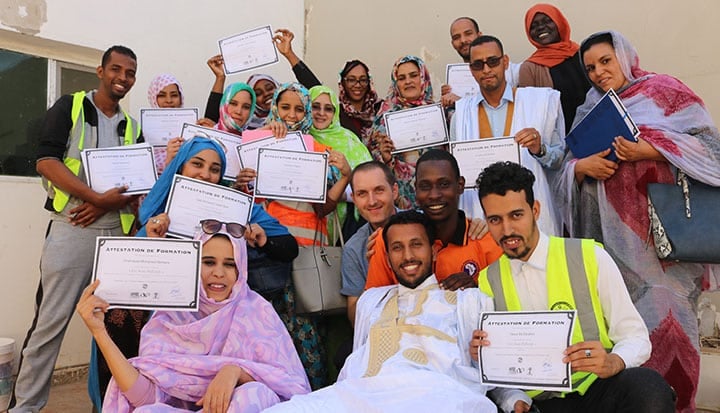CEO, THET and Ian Walker, Director, Johnson & Johnson Global Community Impact
“I was caring for an elderly man with cardiac failure. He had multiple pressure sores and dirty sheets. He was depressed. I dressed the pressure sores and showed the family how to do the same, in employing what he learnt during the training. I could see how I made a positive change in this man’s life and that of his family. The patient remained well until his death. I never say ‘there is nothing more that can be done’ anymore.” Nurse after receiving palliative care training[1]
‘No one gets left behind’: the strapline for the Sustainable Development Goals (SDG) is a stark reminder that, in 2017, there are still vast areas of the globe unable to access the most basic of universal rights and many health themes which remain neglected.
As success stories from the control of Africa’s explosive outbreaks of urban yellow fever, to advances in AIDS treatment abound there are still many that have not made it in to the spotlight. Palliative care is a prime example. It is estimated that over 40 million people are in need of this care every year, 78% of whom are in low and middle income countries.
For the last year, a partnership between the Cairdeas International Palliative Care Trust and Action Sahara pour la Santé, l’Innovation, le Développement et l’Éd… has been working to change this in Mauritania. Through community workshops and health centre visits, UK healthcare professionals worked with their counterparts to improve knowledge and understanding of palliative care.
For many patients and health workers a belief that ‘there is nothing more to be done’ have pervaded due to a lack of focused training. But as Cairdeas argues: ‘Whether people are suffering from cancer, infectious diseases, or effects of severe disability, the needs are similar and the physical and emotional suffering can be enormous.’ The partnership has trained over 85 nurses and doctors. Many are now actively training others to ensure that the quality of life for critically ill patients and their families is improved wherever possible.
So why a piece for Business Fights Poverty? The answer is twofold. Firstly as a charity that prides itself on responding to need not trend, THET works to ensure that issues such as palliative care move up global health agendas. But we also recognise that we cannot do this alone. That is why for the last six years we have collaborated with Johnson and Johnson (J&J) on the Africa Grants Programme, a scheme that has trained over 1,700 health workers and reached 34,000 patients. It is also the programme that has supported the Cairdeas-ASSIDE partnership.
“We are a large multinational but we don’t have the ability to reach out to local communities and that’s where working with an organisation like THET, who have connections with big players in the international aid sector and grassroots partners, is key. We would never get to reach these communities without our partnership.”
Ian Walker – Director, Johnson & Johnson Global Community Impact
Whilst we celebrate the rise of Corporate Social Responsibility, at THET we want our relations with private sector partners to reach beyond this and be clear about the benefits for all involved. Whilst many are still wary of the contribution the private sector can have in international development, there is much for us to learn from one another and we believe that working through partnerships is the best way to make real change happen. The partnership model allowed J&J to make an impact at community level, directly accessing those most in need, as a nurse trained through the Cairdeas-ASSIDE project explains:
I work in an isolated health post. I had a patient with advanced tuberculosis. I sent him to the health centre in Bababé for the treatment. After some time I had received no news about the patient so I went to look for him in his village 5 km away. The family had not followed my treatment advice. I spent time discussing with the patient and his family to convince them of the importance of the treatment. After some days the patient died but I remained in contact with the family providing bereavement support. The training made me more aware of the vulnerability of such patients and their families..[2]
We are reminded that the power of partnership lies in the ability to learn from each other; that healthcare has to be responsive and to heed the priorities within the context we are working. Prescribing the approach to palliative care we adopt in the UK to the Malawian system, for example, would ignore national priorities and community and religious practice and understanding surround pain as well as the great differences in resource levels.
We believe that the SDGs strapline should be a call to all those working towards bringing them to fruition, to form partnerships, cross-sectoral alliances and to share knowledge across unfamiliar boundaries, and are convinced that together we can work to achieve them, leaving no one behind.
If you would like to help us continue the life-saving work we have been carrying out for over twenty-five years please do get in touch.
This article was co-written by Ben Simms, CEO, THET and Ian Walker, Director, Johnson & Johnson Global Community Impact










